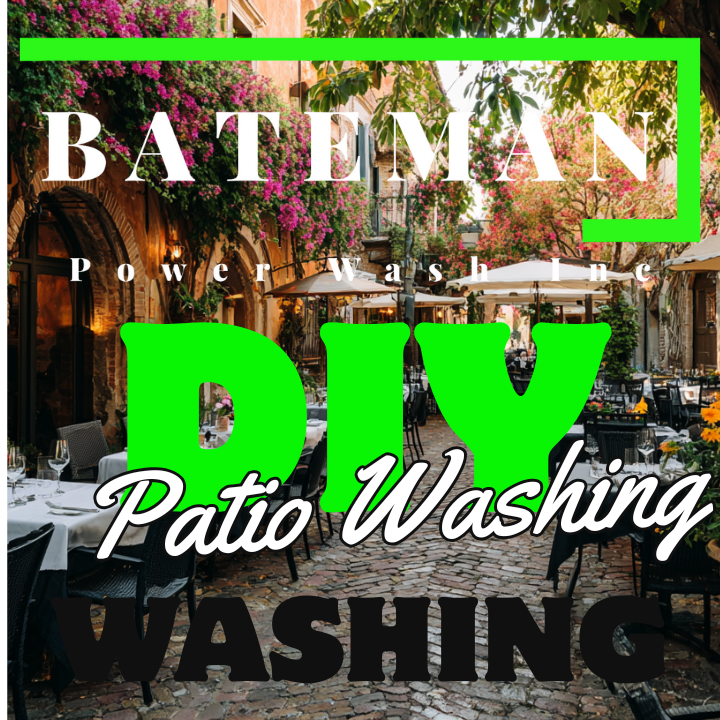Table of Contents
- Introduction: Why Commercial Patios Need Regular Cleaning
- Essential Equipment & Tools Checklist
- Choosing the Right Detergent (And What to Avoid)
- Pressure Washer Settings: PSI, GPM, Nozzles Explained
- Prepping the Work Area: Safety & Protection Measures
- Step-by-Step Process to Pressure Wash Commercial Patios
- Troubleshooting Common Patio Issues (Oil, Gum, Algae)
- Post-Cleaning Treatments for Long-Lasting Results
- Advanced Tips: Speed, Technique, and Avoiding Damage
- Safety Protocols for Technicians
- Maintenance Schedule: How Often Should Patios Be Washed?
- Client Education: What They Should Know Before & After the Service
1. Introduction: Why Commercial Patios Need Regular Cleaning
Commercial patios at restaurants, plazas, hotels, and office buildings face constant exposure to dirt, foot traffic, spills, grease, algae, gum, and more. If left uncleaned:
- Oil and grease create slip hazards.
- Algae and mildew stain surfaces and deteriorate materials.
- Built-up grime diminishes the business’s curb appeal.
Routine professional cleaning enhances safety, preserves surfaces, and maintains a polished, welcoming environment for clients and customers.
2. Essential Equipment & Tools Checklist
- Pressure Washer: 3,500 – 4,500 PSI, 4+ GPM (Commercial grade)
- Surface Cleaner (20″–24″) — For uniform surface cleaning
- Spray Nozzles:
- 25-degree (Green Tip) — General rinsing
- 40-degree (White Tip) — For delicate edges
- Soap Nozzle (Black Tip) — For applying detergents
- Turbo Nozzle — For edges, corners, and gum removal
- Commercial Degreaser
- Sodium Hypochlorite Solution (3-4% applied)
- Eco-Friendly Detergent
- Gum Remover (optional)
- Garden Hose with Backflow Preventer
- Safety Gear: Safety glasses, gloves, non-slip boots
- Plastic Sheeting & Painter’s Tape — To protect nearby structures
3. Choosing the Right Detergent (And What to Avoid)
Ideal Cleaners:
- Degreaser for oil and grease spills.
- SH solution (3-4%) for algae and mildew removal.
- Eco-friendly general-purpose detergent for dirt and grime.
Avoid:
- Straight bleach (can damage surfaces and surrounding greenery).
- Acid-based cleaners on decorative concrete or pavers.
DIY Mix Example:
- 2 Gallons Warm Water
- 1/2 Cup Degreaser
- 1/3 Cup Gentle Dish Soap
4. Pressure Washer Settings: PSI, GPM, Nozzles Explained
- PSI:
- Concrete: 3,500 – 4,500 PSI
- Pavers: Up to 3,500 PSI (with caution)
- Stamped/Decorative Concrete: 2,500 – 3,000 PSI
- GPM: 4.0 – 6.0 GPM for efficient rinsing
- Nozzles:
- 25-degree for main surface rinsing
- 40-degree for delicate trims, thresholds
- Turbo Nozzle for gum, edges, and heavy grime
5. Prepping the Work Area: Safety & Protection Measures
- Walk through to assess surface conditions (oil, gum, algae).
- Move all patio furniture, planters, and equipment.
- Block off work zones with caution signage.
- Cover sensitive areas (doors, walls, windows) with plastic.
- Pre-wet nearby plants and landscaping.
- Ensure proper drainage paths are clear to avoid flooding.
6. Step-by-Step Process to Pressure Wash Commercial Patios
Step 1: Pre-Rinse
- Use 25-degree nozzle to rinse off loose dirt and debris.
- Soak oil-stained areas to prep for degreaser.
Step 2: Apply Detergents
- Use soap nozzle or downstream injector to apply degreaser and SH solution.
- Focus on high-traffic zones and stained areas.
- Allow dwell time of 10-15 minutes, keeping the surface wet.
Step 3: Scrub Problem Spots
- Use push broom or scrub brush on stubborn oil, gum, or algae patches.
- For gum, apply gum remover and scrape gently.
Step 4: Surface Cleaning
- Operate surface cleaner in slow, overlapping passes (30-50% overlap).
- Work from high areas down towards drains.
Step 5: Edge Work
- Use turbo nozzle along edges, corners, and thresholds.
- Ensure detailed cleaning where surface cleaner can’t reach.
Step 6: Final Rinse
- Use 25-degree nozzle to rinse entire area, pushing water towards drainage zones.
- For sensitive edges or delicate trims, switch to a 40-degree nozzle.
Step 7: Spot Treatment
- Re-apply degreaser or SH solution to persistent stains.
- Light rinse for spot cleaning.
7. Troubleshooting Common Patio Issues
| Problem | Solution |
|---|---|
| Oil & Grease Spots | Reapply degreaser, scrub, and rinse |
| Algae/Mildew Shadows | Use SH (4%) and let dwell, rinse again |
| Gum Residue | Apply gum remover, scrape, and rinse |
| Detergent Streaking | Ensure thorough rinsing, mist lightly |
8. Post-Cleaning Treatments for Long-Lasting Results
- Apply concrete or paver sealants for surface protection.
- Suggest anti-slip treatments in high-traffic wet zones.
- Recommend regular maintenance agreements for ongoing care.
9. Advanced Tips: Speed, Technique, and Avoiding Damage
- Use dual-operator system: one applies detergent, one follows with a rinse.
- Surface cleaners drastically increase efficiency and uniform results.
- Avoid high-pressure wand work on decorative concrete to prevent etching.
- Control runoff to avoid dirtying freshly cleaned sections.
10. Safety Protocols for Technicians
- Wear safety glasses, gloves, and non-slip footwear.
- Clearly block off areas with caution tape and signage.
- Avoid spraying towards glass doors and windows at close range.
- Watch for slip hazards on wet concrete.
- Monitor runoff direction to prevent flooding entryways.
11. Maintenance Schedule: How Often Should Patios Be Washed?
| Environment | Frequency |
| Restaurant Outdoor Patios | Monthly |
| Retail Plazas | Quarterly |
| Hotel Poolside Patios | Every 3 Months |
| Office Courtyard Patios | Semi-Annually |
12. Client Education: What They Should Know
Before Service:
- Remove all furniture and obstructions from patio area.
- Ensure water spigots are accessible.
- Inform staff/tenants about cleaning schedule.
After Service:
- Allow surfaces to dry fully before resuming foot traffic.
- Inspect for any areas needing touch-ups.
- Discuss a regular maintenance schedule.
- Recommend sealants for long-term protection.

